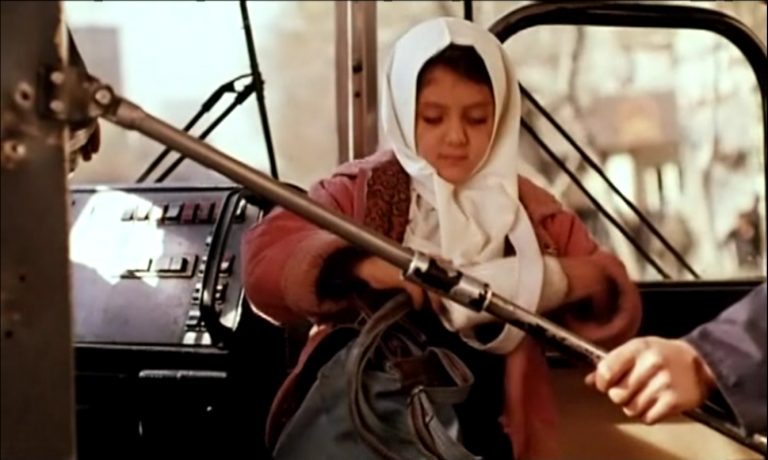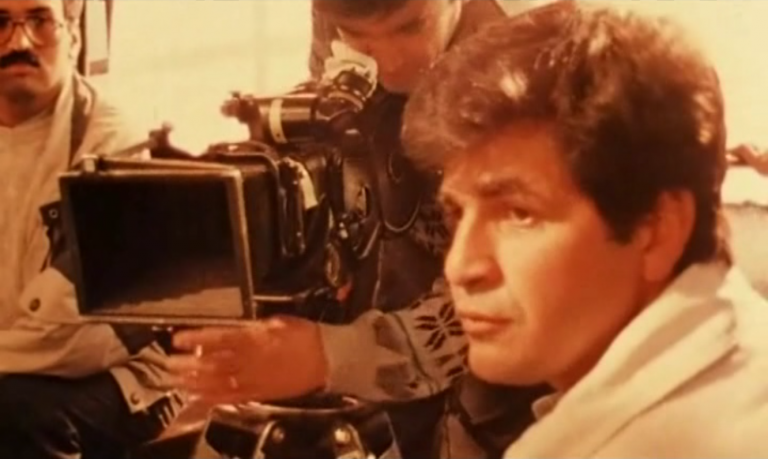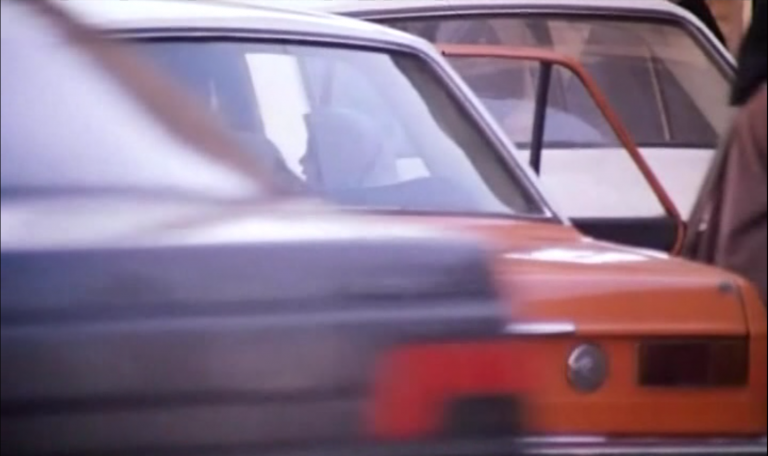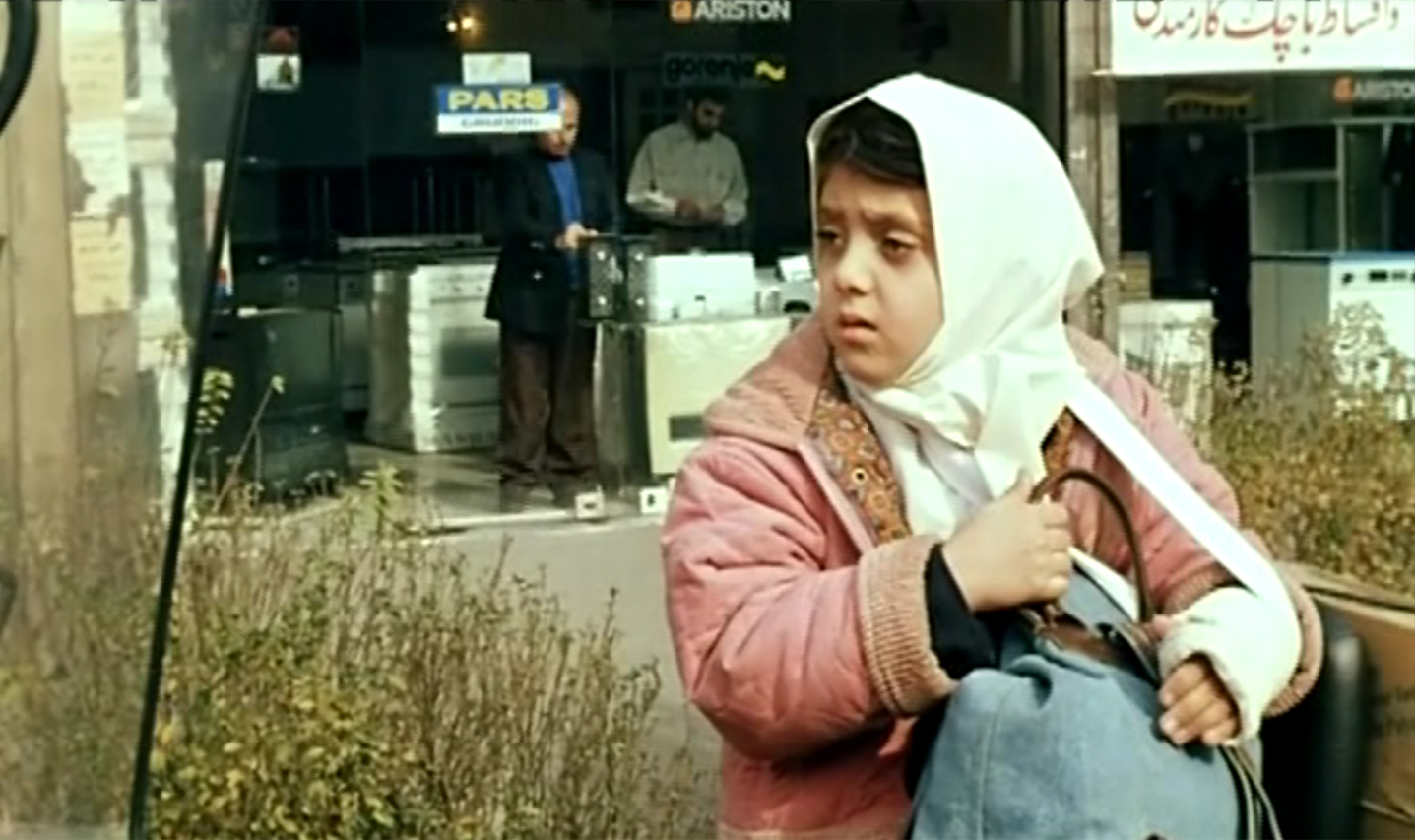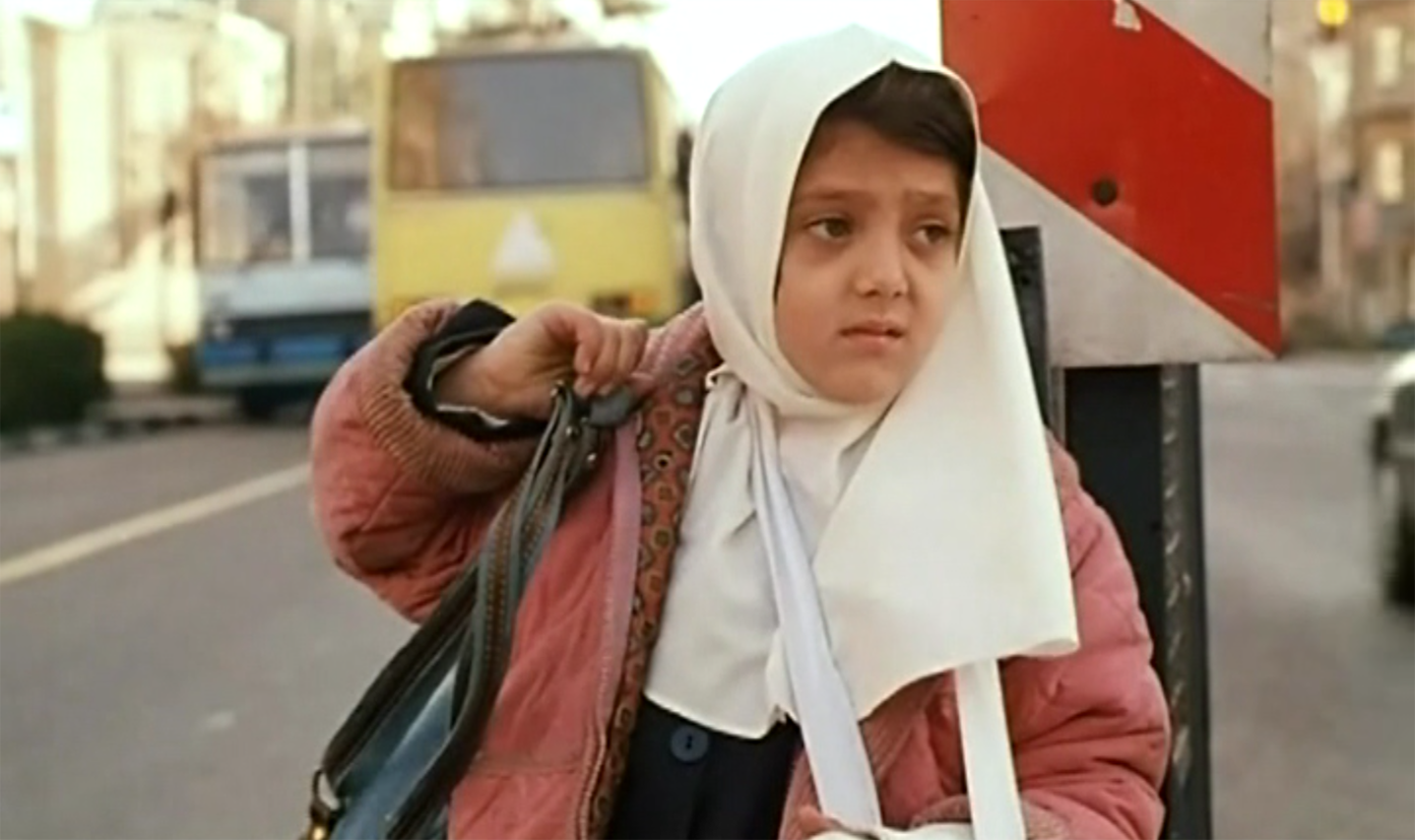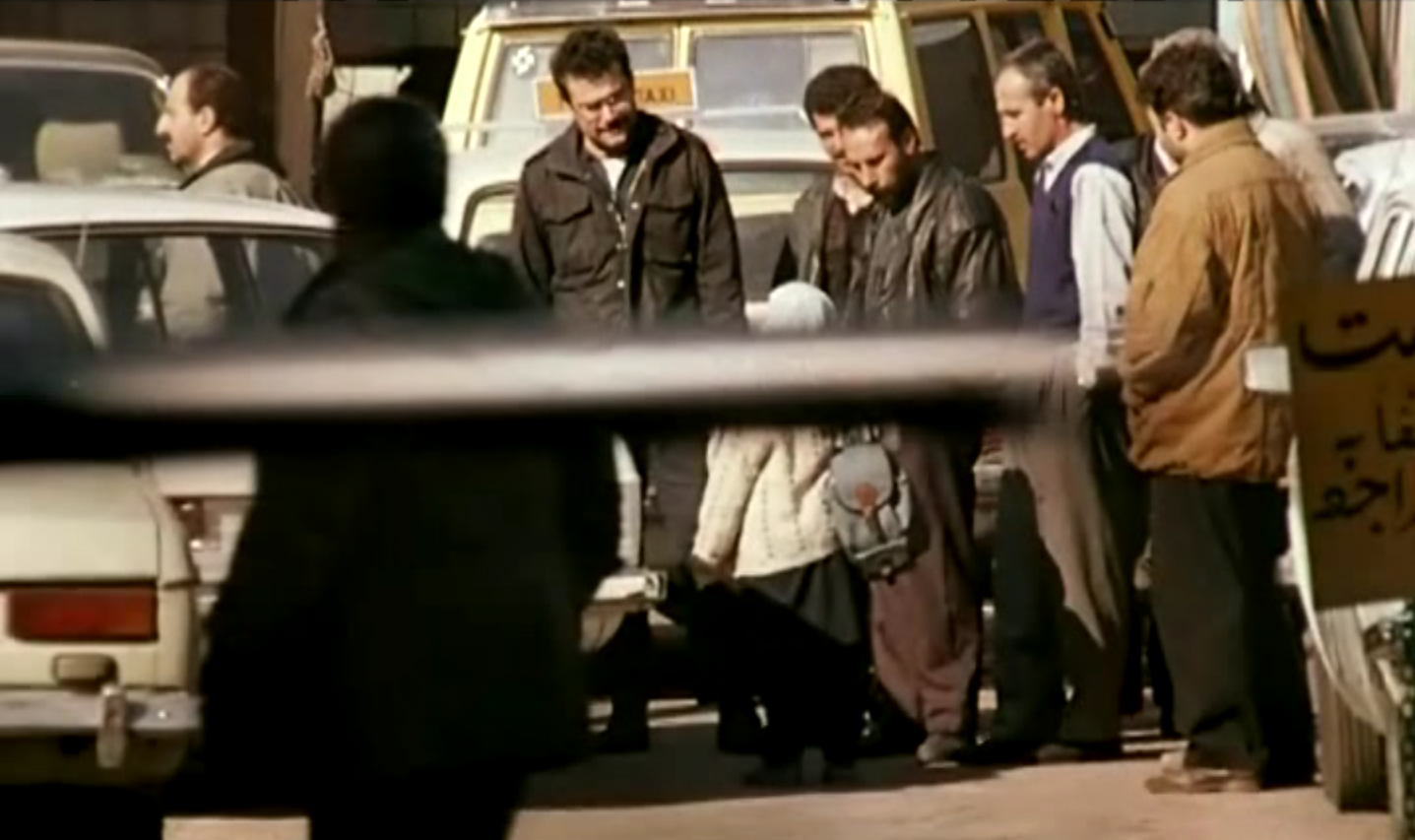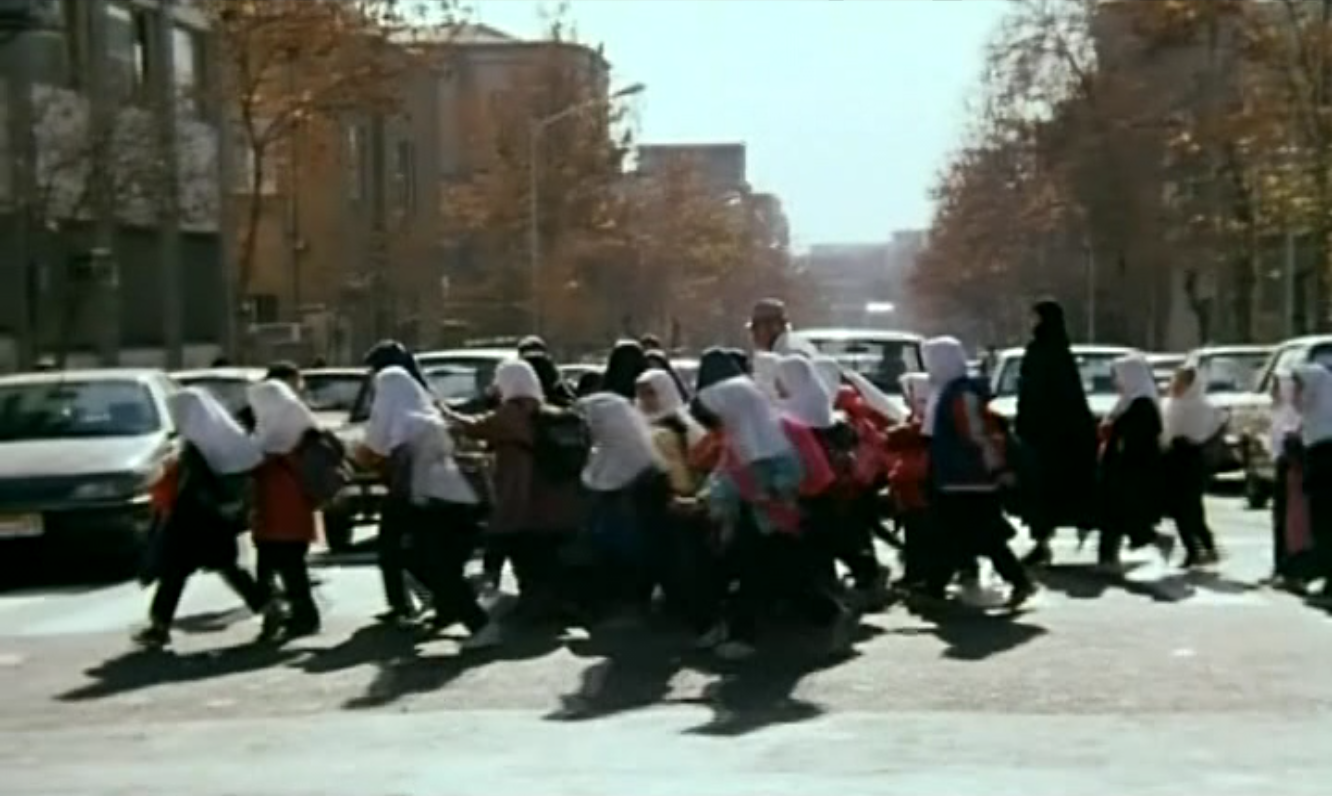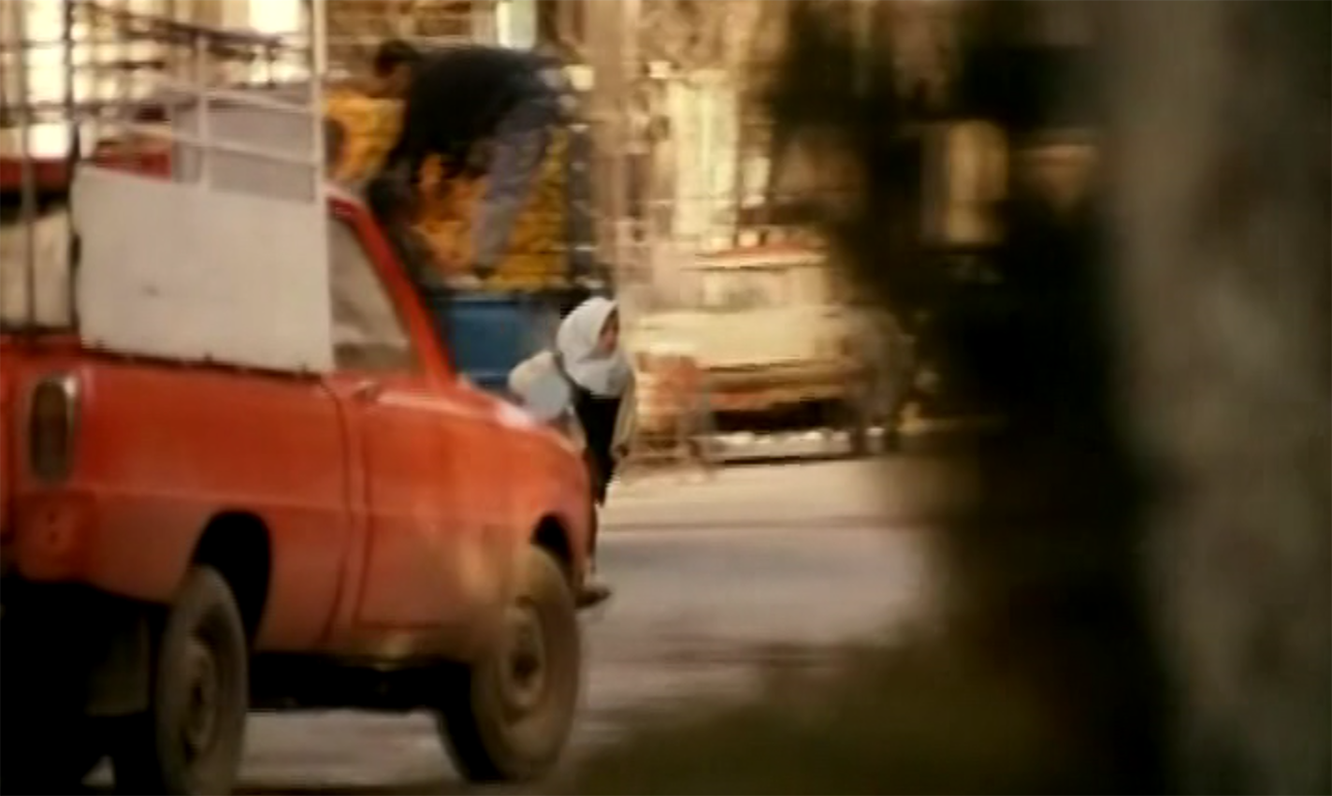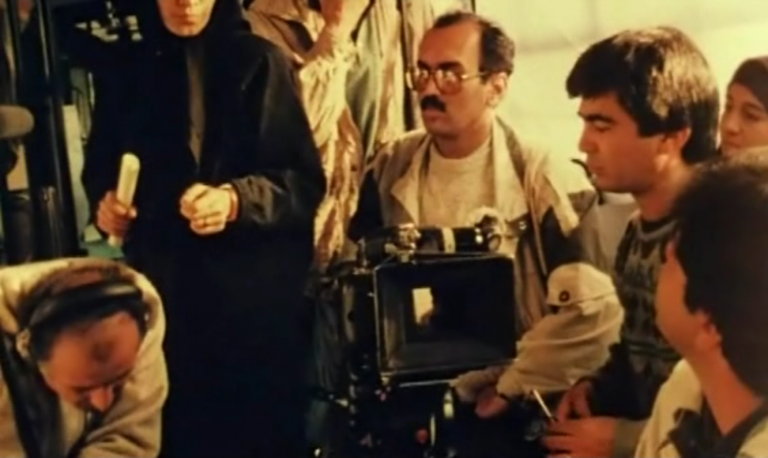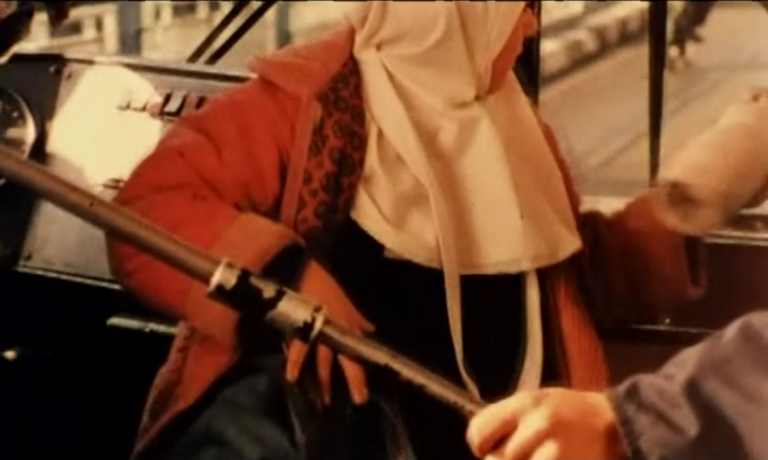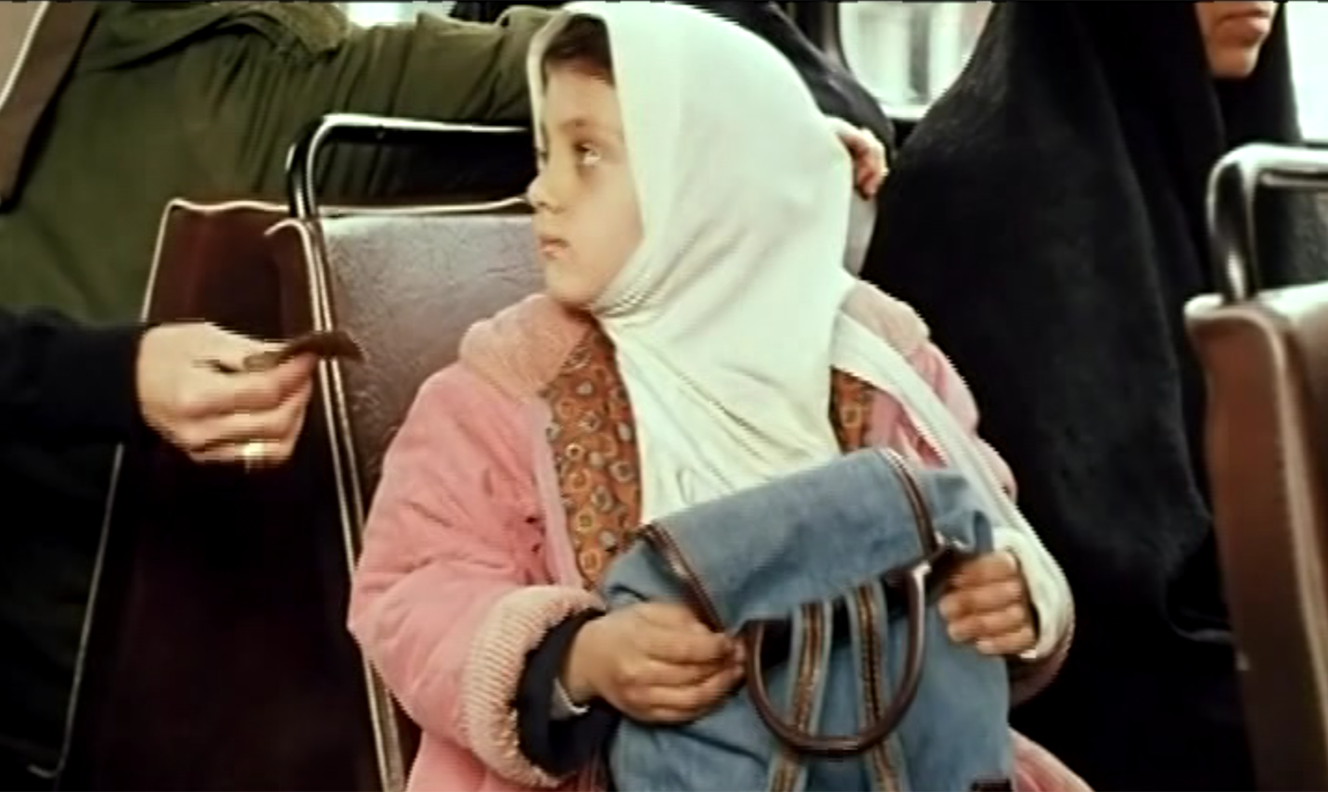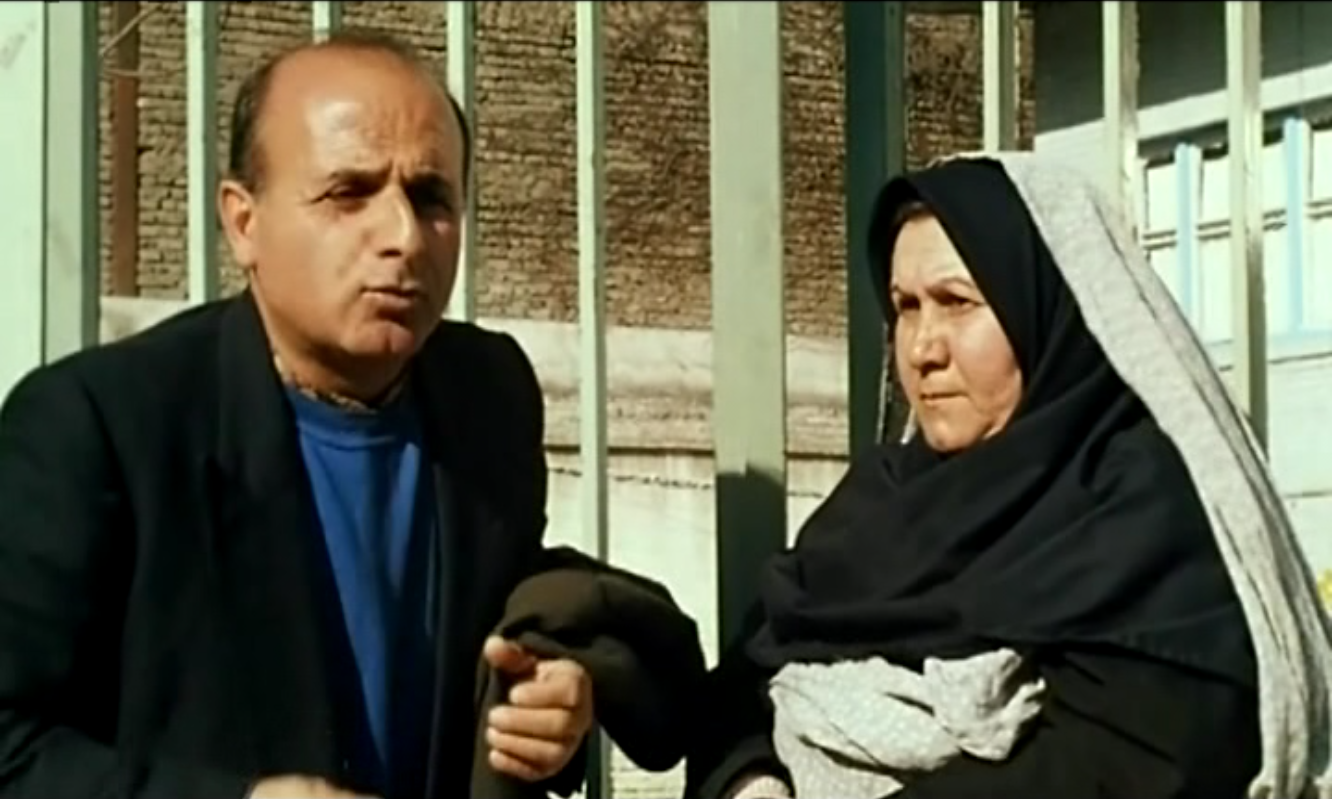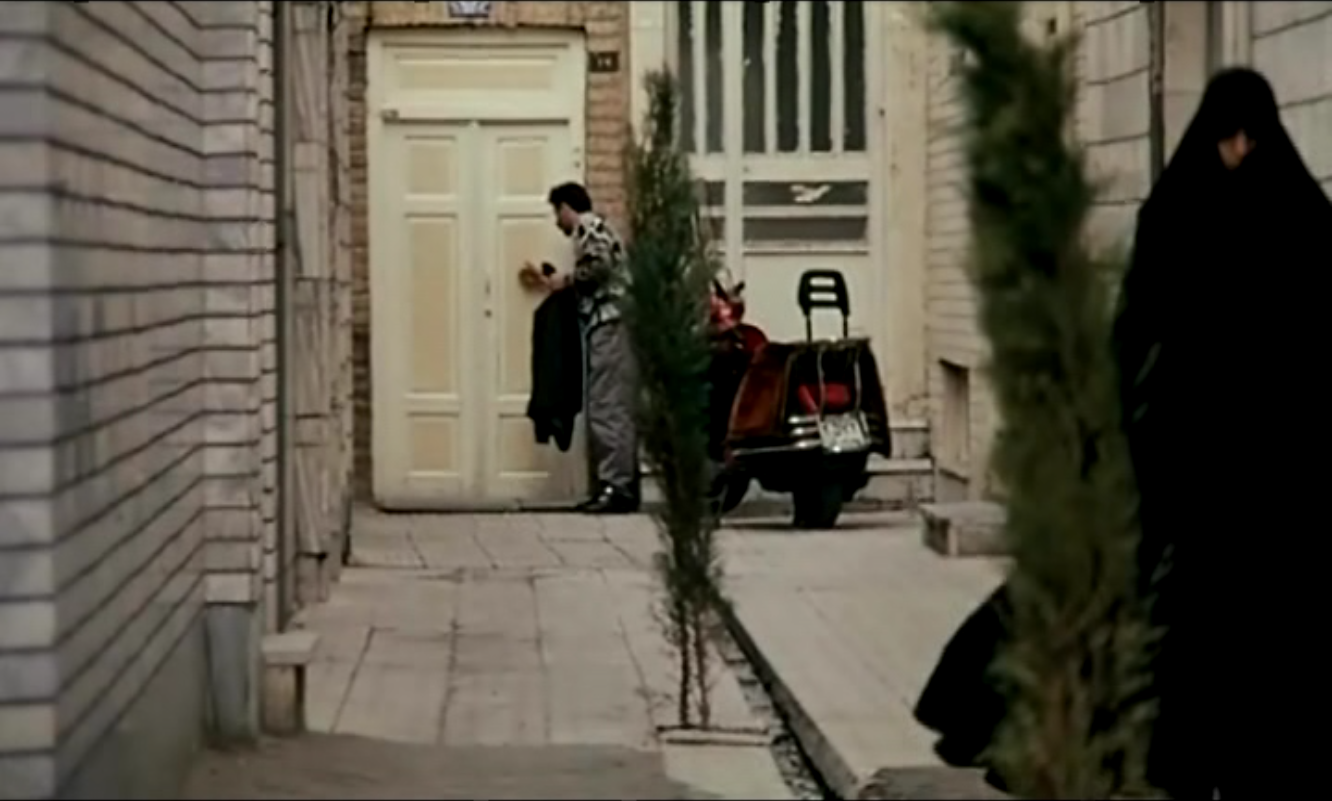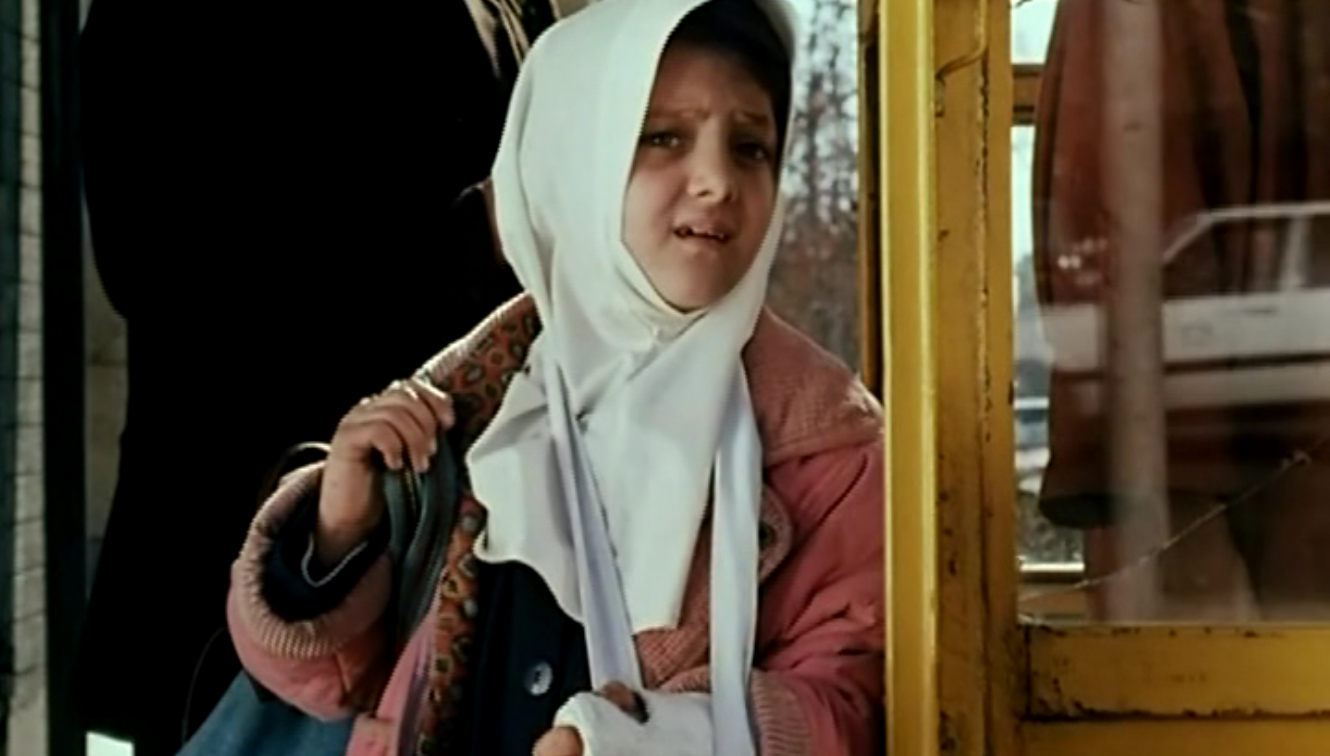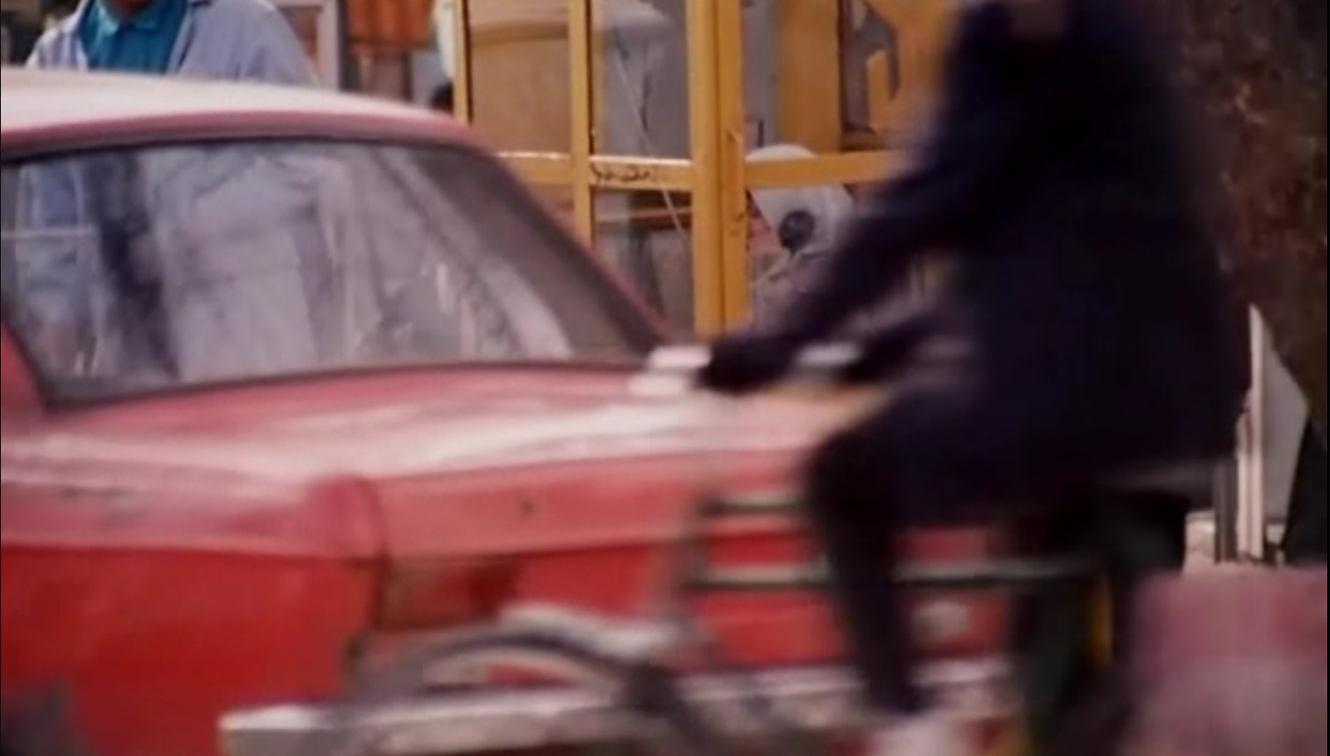TIMOTHY BEWES: First of all, I’m delighted to be joined by my two colleagues at Brown University, Shahzad Bashir and Samine Tabatabaei, both of whom teach in the Department of Middle East Studies. Both of them know more about Iranian film than I do, so I’m really grateful to them for joining me to talk about this film.
We begin each Film-Thinking event by asking the “curator” of the film to explain why he or she chose it. And since I selected today’s film, I thought I would start by asking myself why I chose it, and how the film fits into what the series is trying to do. So, I’ll just say a couple of brief things.
When I introduced the film earlier this evening I said it was a 95-minute film, and that 90 or 95 minutes is the perfect length for a film. But 90 minutes is also, of course, the perfect length for a soccer match. As people will have noticed, the film lasts for precisely the length of the soccer match (between Iran and South Korea) that is taking place during the course of it. That real-time element of the film is something we should talk about.
A couple of things about the director: Jafar Panahi is a prominent Iranian filmmaker who has been active for 30 years or so. He’s a protégé of Abbas Kiarostami, but, unlike Kiarostami, his work has regularly run afoul of the Iranian authorities, particularly in the works he has made since this film. The Mirror is his second feature after The White Balloon in 1995. Subsequently to The Mirror, his body of work became much more directly political and confrontational. The Circle, from 2000, is explicitly about the precarious situation of being a woman in Iran—about, in effect, the criminalization of womanhood. Offside, from 2006, is another film about soccer. Until recently, women were banned from attending soccer matches. So Offside is about a girl who has to dress up as a boy to get into a soccer match. Both of those films were, and maybe still are, banned in Iran.
Panahi is now ten years into a 20-year ban on making films; but during that ban he has made four films (to date), which he has managed to produce while, sort of, obeying the letter of the ban, using highly inventive and creative modes to escape the conditions of the ban. For example, Taxi Tehran (2015) is filmed from a dashcam on a taxi driven by Panahi himself, who plays a taxi driver (although several sequences are filmed by characters with cell phones). There is no filmmaking going on, then, other than this sort of incidental footage, whether from a dashcam or a mobile phone, which then constructs the entire movie. All the shooting is diegetic.
And for me The Mirror becomes especially interesting, then, with the break that happens halfway through the film, when the little girl takes off the cast and refuses to act any more. At that point, the filmmaking apparatus enters into the apparatus of the cinema, which is to say that the film, or the perspective of the camera, is no longer external to the action, but becomes part of it. The camera enters the action and we’re suddenly intensely aware of the presence of the camera. In that regard, the film opens up a conceptual space which is also a real space. This is one of the very interesting elements of Panahi’s cinema: there’s this highly conceptual engagement with the relationship between reality and fiction, between the actor and the character, and between sound and image, and the discrepancy between these things is dramatized for us, situated in a time and place. That, I think, makes his experimentalism deeply social and political in a way we can talk about.
We should also think about temporality. In the second half of the film there’s an exhilarating seven minutes when the gap between image and sound, and thus the technology of the cinematic image, becomes starkly present to us. The camera loses sight of the little girl, Mina. Suddenly the sound that we hear is the sound of her pattering footsteps, and everything we see is without any corresponding sound. What I find so fascinating about this moment is that we get a kind of image (which is to say, a perspective) that is uniquely cinematic. This is why I think this work is an exemplary film for the Film-Thinking series. What does it mean to talk about a distinctively cinematic or filmic perspective, point of view, or thought? Something of this uniquely cinematic capacity to radically separate sound and image has to be part of that conversation.
There are many ways we can theorize this set of distinctions, including the conversation that came out of 1970s/1980s feminist film theory, where the cinematic gaze was theorized as a specifically male gaze. Laura Mulvey’s 1975 essay “Visual Pleasure in Narrative Cinema” made the case for a feminist cinema being one in which — well, what she says is this: “The first blow against the monolithic accumulation of traditional film conventions ... is to free the look of the camera into its materiality in time and space and the look of the audience into dialectics, passionate detachment.”
When the overt presence of the camera is made unignorable, I think we have a compelling case for, in Mulvey’s terms, a kind of feminist cinema that gets away from the apparent universality of the “male gaze” in traditional, narrative-driven Hollywood cinema.
So those are some of the reasons why I wanted to show the film; but let me ask Samine and Shahzad now to say something about their responses to the film.
SAMINE TABATABAEI: I thought I would talk about my point of view as someone from Tehran and knowing the culture intimately. There are elements that are not necessarily translated or captioned, and if you did not get them, then you would miss out on some points. For me, it is very important that it is an entirely urban film, that we stay in the urban space of Tehran, and that we get no glimpses of the domestic space. I think there’s an important statement of this sort at the end of the film, when Panahi closes the door and leaves us behind in the urban space. But I feel also that Panahi is making a very interesting decision by staying and following Mina within one zone in Tehran. If you think about other neo-realist Iranian films, we often go from the north of Tehran to the south of Tehran and see the polarization in social and economic status. Crimson Gold (2003), for example, is the story of a war veteran who, after the war, due to physical and economical difficulties, is delivering pizza in affluent neighborhoods in Tehran. Following him in his daily routine we see different neighborhoods and get glimpses of different economic statuses in Tehran. But in The Mirror Panahi does not illustrate the social heterogeneity, but offers clues in the oral landscape. What I mean by that is that, if you know Persian, you can hear the different people that Mina gets to encounter. They are coming from different provinces in Iran.
Just to give you an example: in the very first encounter with the employees of the school, they were talking with accents from north of Tehran. When the girl goes to the phone booth, the person using the telephone before her has an Isfahani accent; and then the old lady in the bus who complains about her treatment by her children is talking with a Turkish accent. After the breaking of the fourth wall, when Mina is in the taxi, we hear an argument between one of the passengers and the taxi driver.
We hear two different accents. The lady arguing for women’s rights and role in the house has a very Tehrani accent, but the taxi driver, who has more traditional views about the male role in the domestic space, has a traditional Isfahani accent (from the city of Isfahan). I think it’s important how we get to access this socially heterogeneous experience of Tehran in this film, which is very different from some of the other films in this genre, which some people call neo-realist Iranian film, explicating the poor and wealthy. The polarizations are very tangible in those sorts of films.
Also interesting to me is that the Tehran Panahi is depicting doesn’t have the vibe of a big city. Everyone seems to trust each other. It’s very communal; they’re relying on the girl being taken by a stranger, assuming that a total stranger will somehow take her to her place ... I don’t think that’s ever going to happen! In reality, if there is a girl of this age without a companion, everyone would call the police. They would not let a total stranger take them here and there.
Should I go on?
BEWES: Yes, please!
TABATABAEI: I was also reading about the prominence of children in this genre of neo-realism. A lot of Iranian films in the 1990s have children as the main character: for example, the Koker trilogy by Abbas Kiarostami (1987, 1992, 1994), and Bashu, The Little Stranger by Bahram Beizai (1989). There is an abundance of child protagonists in these films. There are a few scholars who try to explain this as a kind of compensation for the very strict, overly regimented codes of visibility for women in Iranian cinema. In a way, these directors — who are, in a sense, committed to “realism” — do not want to take their camera to a private space in order to present women in certain ways in order to abide by government codes of propriety. Thus Abbas Kiarostami during this time takes his camera to the countryside and makes a film about children. There is this tendency to avoid and circumvent codes of propriety and the censorship of women by using children to create a subaltern space and to get away from the official discourses.
If you take this rationalization seriously, then the character of Mina becomes a very allegorical figure. The way she revolts against the entire production and throws off her hijab becomes a political statement about the situation of women. Thus we see that this is an important transitional film for Panahi, because at this point he is still using allegories and metaphors to make his social comments; after this film he does not try to cover his message in this way. The statements he’s making in the later films are very radical.
SHAHZAD BASHIR: Thank you, Samine, and thank you, Tim, for including me in this. I am definitely not an expert in Iranian film of any sort whatsoever; and I have not lived in Tehran except for visiting a couple of times, so it was actually fascinating to hear what Samine is describing. The one thing that stood out to me in the film was the way the narrative is constructed. There are three elements going on in a film: one is the story, second is the visual narrative, and then the oral narrative. What was interesting to me was that all three of them get broken at various points and displaced. The overall sense I had of the film, watching it the first time and then again this evening, was of this effort to displace. The narrative gets displaced because it’s broken, because of the breaking of the fourth wall, the moment Mina looks at the camera. The visual is constantly broken up, because things are passing in front of the camera. I didn’t do this very systematically, but before the change happens there is a way in which the camera seeks out the human figure. After that — because of the conceit that they’re just following her — there are constant hindrances coming in front of the eyes as we go along. Then with the sound, as you said — that one long section where the sound is completely displaced and in other sections it goes in and out; and with that I almost thought that the second part makes one really think about the first part, which is supposed to be a “normal” film, in which the figure of the girl becomes a kind of receptacle into which all of these conversations are pouring.
This is just to follow up a bit on what Samine was saying about how the girl comes to refract all of these social discourses that are happening. To take a medium that is essentially dictatorial, to construct something within the medium that is constantly challenging it — along the lines that you were just describing; to do it successfully, and to keep the attention of the viewer, is quite an accomplishment. Recently, I was reading some experimental ethnographic narratives in which the ethnographer does not want to sign up to an objective viewpoint on the society that she is looking at. So she did all kinds of tricks to make this happen. I thought it was very successful, but it required a lot of effort to absorb it. It made me think about how complicated it would be to put something like that together, in which one is narrating while working against the very notion of a narrative, and to do it at three different levels at the same time — this seemed to be quite an amazing thing.
The other thing I have to say is that both times I’ve seen this film it produced in me great anxiety — having had a child who was that age at one point. The idea of a child being loose in downtown Tehran is like a nightmarish situation.
That anxiety is very much there in the film; but it is also, somehow, able to make the viewer comfortable, in a curious sort of way, in terms of buying into the conceit or the premise. So there, too, it seems like one of those things that is so carefully put together in its supposed randomness that it is able to manage this.
BEWES: I see what you mean: one never thinks that the girl is going to die. That’s simply not going to happen.
AUDIENCE MEMBER 1: I just want to ask a point of clarification, because we’re looking at subtitles. It seemed to me that Mina got more competent or self-confident at the end. In the early part of the film, she was very anxious. When she was acting, she was fearful, tearful, and even when she first stopped acting, she was still struggling to find her way. But towards the end she was putting together clues. Did it seem that way in what you heard, in the language, that she became more confident that way?
TABATABAEI: Not necessarily. But since you are bringing this up, I would say that in the second part of the film she gets to follow her own mind, it is her own mission to get home. It’s not scripted for her to do. But I don’t know, I didn’t get that.
AUDIENCE MEMBER 1: She saw things that she recognized: her father’s car, the person in the blue suit. It just seemed like the pieces were dropping into place, whereas before, you know, she was just randomly ... it’s up there somewhere.
TABATABAEI: Actually, that’s a very good take. If you think back to the beginning, she was being this puppet, playing for Panahi. In the second part, she is determined to find her way home and get herself free from the director.
BEWES: I think there’s also something interesting in the fact that all these elements of story and narrative, the characters that she knows, shops that she recognizes, the policeman who once found her father, the mechanic who once repaired her car, etc., all these moments, which are moments of story, become utterly instrumentalized; they are there solely for the purpose of re-orienting herself. That I think is super-interesting, in terms of this kind of displacement of story.
AUDIENCE MEMBER 2: And the point of view of a child, which the adults didn’t necessarily connect with. They didn’t remember the details that she did — that she had gotten a drink, for example. The point of view was interesting.
AUDIENCE MEMBER 3: I thought that Mina was being used as a commodity throughout the whole movie. At first by the film crew and then, if she was escaping from them (or even if that was intentional), I think she was truly panicked. It certainly came across that way. The crew persisted in allowing her to be lost. She does find her way home. At the very end, the man who had found Mina, from the crew, says, “Well I can find another child who’s just as talented — forget about her.” This little 5- or 6-year old went through a pretty epic experience, and I felt uncomfortable about that aspect.
EVIE LINCOLN: I agree with you totally. I felt like it was the film crew who were really bad guys. The moments of freedom were when the camera and the sound were disconnected. She was only furious at that moment when she changed over to being Mina and then she was confident. Even though she was lost, she never burst into tears again. She was just trying to get home. Those wonderful moments when the sound and the camera disconnected, we thought, “She’s free of them!” Then the awful film-person with the mic coming and finding her, stalking her.
So I just wanted to hijack this for a minute, because I agree, it was very uncomfortable. The filmmakers were bad guys. There’s a genre of lost kids in cities, with neo-realist film, such as Bicycle Thieves (De Sica 1948), where all of society fails the family, or Alice in the Cities (Wenders 1974). Bicycle Thieves is a political film. The jury’s out for me on whether Alice in the Cities was; but there are so many of these.
I wonder if that’s in Panahi’s mind, or if you see a connection between the point of view of the innocent child and the society that’s failing them, or as a genre ...
BEWES: Samine, you brought up the idea of the children and censorship. I read that films featuring children in post-revolutionary Tehran, in particular, were simply subject to completely different censorship rules. Maybe you were saying this in a subtler way. So, in fact, making films about children became for a generation of filmmakers a way of precisely evading very stringent censorship regulations. Does that chime with your knowledge, Samine?
TABATABAEI: This strand of filmmakers use children as their main characters, but they are not targeting children. Because at the same time we have children’s films that are sort of like musicals. They are really happy films. I don’t know which ones you are talking about. The way these people — Kiarostami and Panahi — are using children in their films is to do away with the representation of women, which was very codified at the time. But to draw on Shahzad’s comment that the film is very anxiety-inducing: many of us watching the film automatically empathize with the child — with Mina — but I think this also speaks to the issue of film production in Iran and the difficulties associated with it. To contextualize this: if you want to make a film in Iran, every step of filmmaking has to be endorsed by the Ministry of Islamic Culture and Guidance. In the beginning, your script has to be endorsed, to make sure it doesn’t have any problems of “intimacy,” say, or subject matter which is not “Islamic.” If you make it through that stage, you then get into the issue of the cast: your list of actors and actresses has to get endorsed. So imagine a filmmaker like Panahi, who has come to the point at which he can shoot his film; and then this child is not cooperating. It’s good to have in mind that it’s really difficult and haphazard to deal with the regulations of filmmaking in Iran.
AUDIENCE MEMBER 1: But the film is obviously a conceit. That second part was in the script.
TABATABAEI: Was it? Do you know that?
BEWES: There are certain moments where that is revealed. For example, the conversation between Mina and a man we never see, because it takes place during the split between the sound and the image. This man, who is apparently the person who dubbed John Wayne into Persian, says to her, “I saw you. I saw you outside the school. You were really good. That was two weeks ago. I saw you acting.” And then: “Later, outside the pharmacy, that was a great scene, you are a really good actor.” I think those are just moments where Panahi wants to make absolutely unignorable the fact that it’s a conceit.
AUDIENCE MEMBER 1: It’s a conceit; but I wanted to ask: when she throws off the yoke is it an allegorical presentation of the constraints women are under in this society? That’s the conceit of the film. It’s creating an allegorical woman, throwing off her head covering, and acting independently, getting home on her own. She doesn’t need men to do that. That’s what the film is about.
ELIZABETH WEED: I think there’s more to it than that. Whether it’s a conceit or not, what’s absolutely fascinating to me about Mina’s making her way through the world is what she used to figure out where she was. When she comes up with these great details — whether it’s the park and the fountain, or things like the car that was fixed. This is in the context of what you were saying, Tim, about early feminist filmmaking that was trying to undo the patriarchial gaze, and also the patriarchal epistemology, undoing mastery. Her way of charting the world reminded me so much of Michel Butor, a French nouveau romancier who was writing in the ’50s and early ’60s and had protagonists who were lost in the city, doing very much the same kind of thing: putting together these minute details about where that was—that park looks a tiny bit different from that one. I kept thinking of Butor when I was watching her negotiating her way. Actually, it was so skillful that that’s when I began to think that this isn’t real.
LYNNE JOYRICH: I think what everyone’s been saying is incredibly interesting, but there’s a way in which there is still a sort of undecidability; the film is really removing mastery from you, the viewer. Even as the character is gaining agency in these brilliant ways — her ability to make the phone call; hanging up — at the same time, much as I was like, “this kid can do anything,” I was also constantly terrified for her. It’s very interesting what you were referring to, Tim — the Mulvey piece — which I thought about myself. In a way, it describes exactly what you were saying about breaking the gaze down into dialectics and materiality—but not, I would say, “passionate detachment.” I didn’t feel detached at all. I felt both totally anxious for the girl and, at times, amused by her. There are also some very funny moments, like when she’s watching the couple on the bus and we see what she sees. I felt the opposite of detachment; but it is interesting that the film disorients you and then makes you think about how one can re-orient. Even the movement around the space can be so disorienting, but then you see how she orients it, by, say, holding onto somebody as she’s trying to cross the street. There are some things that seem like large-scale issues, like when they’re having a debate about gender politics, or the issue you talk about, Tim: the comparison of living in the world to playing a soccer game, and your national status that’s being fought for. But it all happens through these little details that are both disorienting and re-orienting in other ways. So, the way that, to use the old terms, the form and content come together is just brilliant.
ELIZABETH WEED: Absolutely: the effect on the viewer.
STUART BURROWS: Going back to Evie’s point about Italian neo-realism: you can see a through line from Antonioni to Kiarostami to Panahi. There’s a kind of Iranian film that makes itself up out of its whole field. For example, in the Kiarostami trilogy there’s Where’s the Friend’s House? (1987) but then the second one, And Life Goes On (1992), is basically being made up out of the first one, the search for the protagonists in the first one, who of course are children. There’s another child in And Life Goes On. It’s a film in search of itself and then it becomes a film. That’s something that Panahi, in this film, is also doing. The most extraordinary moment is the one mentioned in the handout, with the policeman. The question is: “Where is the film?” What you see isn’t the film, really. What you’re hearing is, occasionally, her footsteps. You don’t know where the film is, you don’t know where to look. And then 3 Faces, Panahi’s most recent film (2018), does the same thing again. You’re watching a film, but the director doesn’t know if there’s a film until he’s made it. It becomes a film out of itself. It seems to me a peculiarly Iranian genre: taking the terrifying space (and the things that can happen to you) in Italian neorealism in the city, as well as the things that get lost, and the things you can’t lose, and making all of that part of the form, in the most extraordinary way.
JOYRICH: Can I just say one thing about that moment where, as you said, it loses the film. When the policeman appears, the policeman is asking him for his permit to film. He has to show the permit to film in order for them to let him go. So what you were saying, Samine, about having to get permission every step of the way: this was clearly his authorization. That’s exactly losing the film at the very moment he is supposedly getting authorized to make it.
BEWES: I almost think that the 20-year filmmaking ban is not only the best thing that could have happened to Panahi, but the most appropriate thing. You’re right, Stuart. I don’t think he’s ever been making films. Maybe The White Balloon is a film. Maybe the first half of The Mirror is a film. But then it seems to me that he recoils from the entire business of filmmaking. Perhaps this is not quite the case with The Circle, which is a much more straightforward, horrifying, bleak depiction of life in Iran. But there is a sense that Panahi really comes into his own when he’s able to escape from film.
JOYRICH: Yet he’s so insistent about making film.
BEWES: We haven’t mentioned his most famous film, which is called This Is Not a Film (2011), the first film he made after the ban, which was famously smuggled out of Iran in a cake and shown at the Cannes film festival. It’s essentially a film about an imagined film. Panahi, having been condemned not to make any more films, invites his filmmaking friend (Mojtaba Mirtahmasb) over to document the attempt to try to envisage a film in his apartment. So that is completely to the point.
AUDIENCE MEMBER 3: The question that’s sort of hanging in the air is: what was the point of the cast in the first place? I don’t see what it’s doing, narratively, although it enabled Mina to throw off the cast in a very dramatic way, which was very effective.
BEWES: Oh, you mean the cast on the arm!
AUDIENCE MEMBER 3: So we see her struggling with her backpack ... I don’t know how disabled she is?
BEWES: Well, I don’t know if you noticed it, but she leans on that cast many times during the first half of the film.
AUDIENCE MEMBER 3: Yes, and she’s slugging around her bag with it.
AUDIENCE MEMBER 1: I hadn’t thought of it that way, and I certainly don’t have an answer, but it certainly strikes me as part of throwing away whatever the constraints were. I’m not sure what that represented, but she emphatically threw away that cast. She went wham! The gesture was a cut.
TABATABAEI: I have some thoughts on that. If we take Mina as this allegory of women’s representation in Iranian cinema. At some point, they ask her, “Why don’t you want to continue being filmed?” She answers, “They want me to play this tomboy who breaks her arm, that sort of thing.” That speaks to the stereotypes of women’s representation. At some point in Iranian cinema you begin to see women in some films, which are screened in public. There were certain stereotypes: domestic space, mother figures. That speaks to these strains of women’s representation on screen.
LINCOLN: The whole first part of the movie is full of that. She says in that moment in front of the pharmacy, “I didn’t want to wear the stupid cast. I didn’t want to cry.” The first part starts with — well, the sound is amazing in this movie. It’s really a thing in itself. It starts with this shrieking, wild shrieking, that immediately turns into a live girl being stopped at a pedestrian light, so she’s always being kept in control. Then, all through that first part, as much as she’s trying to be on her own, she’s told: give this musician money; don’t sit in that seat. She doesn’t like it, but she’s submissive enough. She plays the good girl. That all ends after she takes off the cast. Then she’s just herself. People say, “Wait here with the policeman.” She doesn’t. She gets out of the picture-sound continuum.
And then she has this data set that’s like her own data set, and somehow it works. It’s always sort of tangential to any information that the real world needs to get from one place to the other, but she makes it work. She insists on it. It’s a completely different thing. You can see why she didn’t want to act. It’s all about controlling her own movements.
BEWES: There’s a sort of vehicular logic to those moments. When she crosses the road, she uses a woman in a burqa and a man as vehicles.
LINCOLN: Find tall people and walk next to them!
AUDIENCE MEMBER 1: The part that struck me was the old man who walked part way across the street several times. What did that represent? She looked back at him, he would walk a certain distance, and then walk back. It was strange. It was good.
JOHN CAYLEY: I have a question about the cast.
BEWES: Which cast? [laughter]
CAYLEY: The cast. Because I agree that the cast could be interesting. I’m speaking as a relatively naive viewer of the film. The first part seems to be naturalism, and the girl is acting in a naturalistic context. But is it possible that the cast is there in order to be specifically a sign of the unnatural? In other words, she can act all the other things perfectly naturally. She can’t “act” the cast. She’s going to lean on it. She’s going to do that wrong. But I don’t understand the situated gestures of the culture, so I don’t know whether it sticks out in the way I imagine it might do with a girl acting in a cast. Does it stick out? Does she make obvious mistakes with the cast in the first part of the film?
BEWES: I didn’t notice it the first time I saw it, but watching it now you see her leaning on it constantly and using it to almost clamber up the side of the phonebox.
But there’s an interesting moment at the beginning of This is Not a Film that’s worth mentioning. The film is a documentary, essentially, or it looks like a documentary — insofar as we know what Panahi is doing in any of his movies. He’s sitting filming himself at his kitchen table, waiting for a phone call from his lawyer to tell him how the appeal against the filmmaking ban has gone. He sets up his camera and he eats his breakfast and he’s talking to the camera. At one point, he almost loses emotional control and says, “I hate what I’m doing, setting up this camera like this, speaking to the camera. It’s so fake. I need to take off my cast and throw it away,” and he refers explicitly, obviously, to this moment in The Mirror. So, I think that moment has had a powerful effect and has massive significance throughout Panahi’s body of work, and to his contemporary predicament in particular.
BASHIR: It’s interesting to think about this “allegorical” reading — whether as a general allegorical reading of the story or in particular elements. I wonder: is he then successful? Because he might have broken down the filmic medium, but is he then completely reabsorbed in the allegorical medium? If we read it that every element in the narrative is allegorizing, in particular with respect to gender roles, then it is a film that is very specifically tied to a socio-political end, which seems very coherent; but on the other side, it’s trying to be incoherent. I’m not necessarily saying the allegorical reading is wrong, but it seems to me that this produces an interesting question of what is happening here.
BEWES: I don’t think it can be limited to an allegorical reading. It seems to me to be about narrative and cinema, but it’s also about time and movement. It’s a film that is not just an allegory. I almost hate talking about this film, because it seems so smart about what it is doing that anything one can attach to it seems to take something away from it.
AUDIENCE MEMBER 1: I think that’s one of the things about film. Any film that’s made is interpreted by the audience based on their own background, experience, and anything else. The only time we reach these types of — well, whatever it is that we’re doing now — is when we talk about it as a group. Individuals, couples, that talk about it may have had a total surface reading on it. Someone may interpret it just as a comment on Tehranian social-economic life ...
BEWES: Which it obviously is.
AUDIENCE MEMBER 1: Because we’re talking about it, we assign different levels to it by gathering information on the way other people experience it who have different filters than we do as individuals. Film classes are always like that ... [laughter]
WEED: In the context of what was said about whether it was an allegory or not, I just want to report that these two arch-feminists here [indicating Joyrich and herself] did not particularly care that much about the allegorical point about women. It seems OK—I mean, sure, it’s a little obvious. It seemed to me that so much more was going on. I was a little surprised that you, Samine, actually thought that it was ...
TABATABAEI: No, it’s not mine. I was referring to the present scholarship about 1990s Iranian cinema. Panahi’s doing several things. One would be the allegorical use of the presence of Mina. The other thing I wanted to mention is that, in an interview about The White Balloon I was reading recently, Panahi talks about his process of filmmaking, and how he’s very open to accident and improvisation. Not everything is planned. He also uses nonprofessional actors. So he was saying in this interview that he did not write the dialogue in The White Balloon. “We [Panahi and his crew] set the stage and talked about the situation. We asked the actors to do what they thought would happen in this situation.” I’m not claiming that is a totally allegorical film, but we have to bear in mind that there were codes that needed to be complied with in order to make a film in Tehran, in order to have an interesting and smart film. One possible reading is this allegorical reading. But he is doing several things.
WEED: There’s a question here about what it means to allegorize. One of the things that’s being put into play here, it seems to me, is the restrictions that the whole culture, every culture, is working with, and these restrictions are very particular. They’re about papers. They’re about interactions with certain people; and the tensions and the anxieties and the interest and excitement about them is what gets allegorized, it seems to me, in a larger context.
TABATABAEI: One thing I want to point out about Kiarostami and Panahi: these and other interesting Iranian directors, who are celebrated outside of the country, do not necessarily have a theoretical background or are necessarily thinking about allegory in the way we would think. They are much more interested in the language of cinema and being very creative. This sort of theorization happening in Western academia, especially the way Iranian neo-realism is being defined and talked about. I’m pretty sure that this treatment of film is being translated and transported from outside to inside Iran, not from inside to outside. The film is coming from inside. The way we are treating this is because we have these backgrounds of reading Mulvey and all that.
AUDIENCE MEMBER 4: A little detail: can someone explain or did someone understand what the jacket is that the man brings back at the end, to Mina’s house? He’s giving her something that she doesn’t want to take.
TABATABAEI: The microphone?
AUDIENCE MEMBER 1: No, no, there were two jackets in the movie. There was the first scene, the one with the green jacket. Then, at the end of the film, she’s in the house, a man drives up on the motorcycle — again, a motorcycle — and tries to hand her a jacket and she refuses the jacket again. So, the same thing happened twice. I could not assign any value to it, but she is asking a good question.
BASHIR: I thought that was the mirror effect, because the doorway with the jackets, the discussion ... That was my speculation on the whole mirror business. There are many other things that are directly correlated, the two phone booths. There’s all this mirroring going on, so I presumed ...
AUDIENCE MEMBER 1: Yes — two squares. I understood the twos. That makes sense. So it was literally an end piece.
AUDIENCE MEMBER 4: And the bus, the two directions.
AUDIENCE MEMBER 1: Yeah, exactly. A broken continuum, but the continuum is there.
BASHIR: When she’s standing at the very end, there’s the absolute refusal to make the film. Once the film is done!
BEWES: She’s made it.
AUDIENCE MEMBER 1: The soccer match is ended! Thank you for your time.
BEWES: Thank you, everybody, for coming. Thank you, Shahzad. Thank you, Samine.
